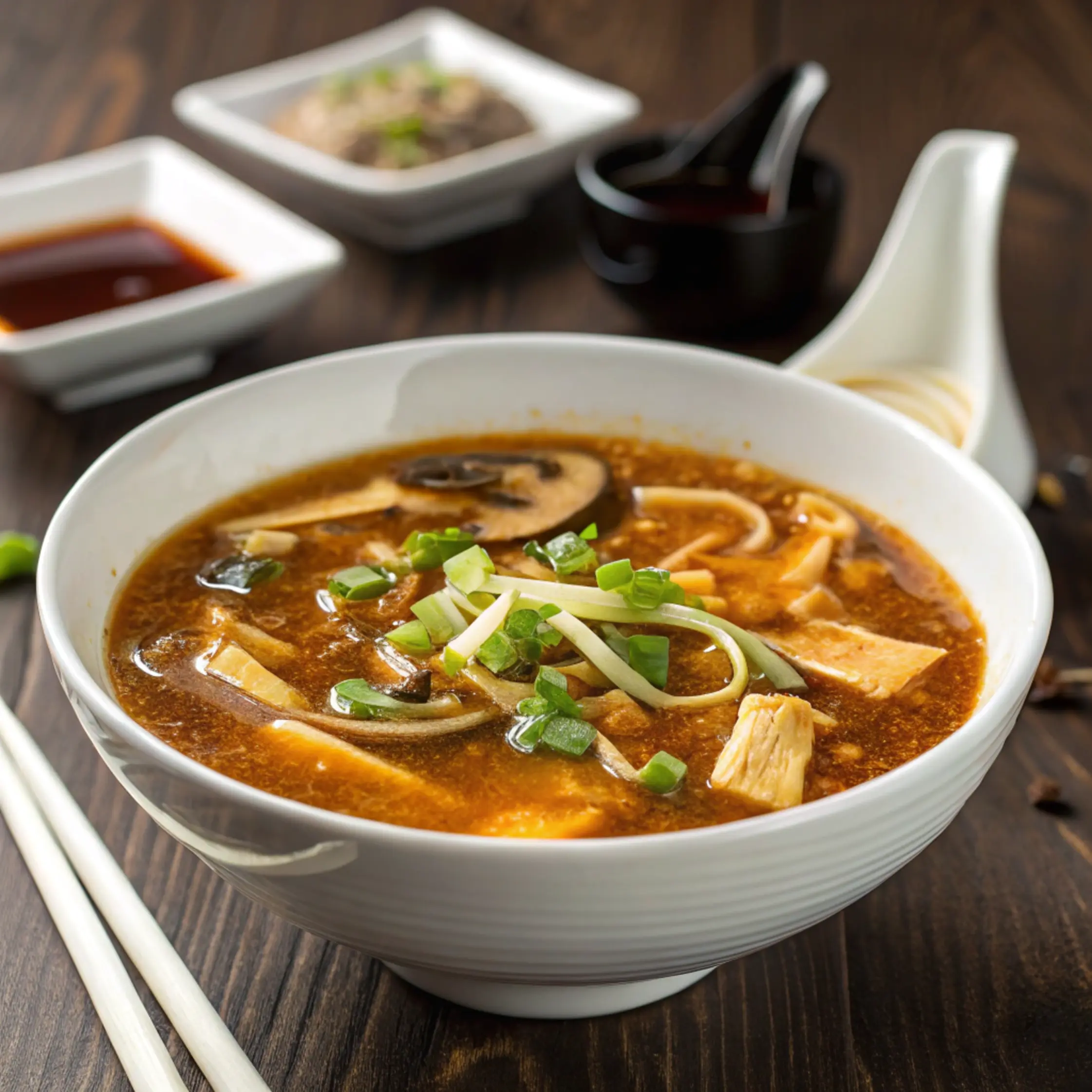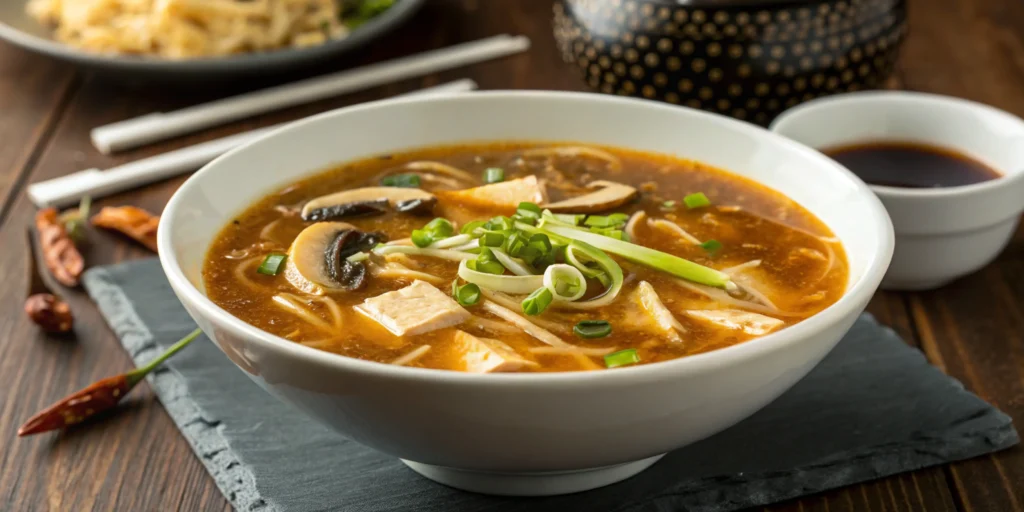There’s something magical about a steaming bowl of hot and sour soup. It’s the ultimate comfort food—spicy, tangy, and full of textures that make every bite exciting. Whether it’s a chilly day or you’re simply craving bold flavors, this soup hits all the right notes. Let’s dive into the recipe, tips, and variations to make it your own.

Table of Contents
Ingredients for Authentic Hot and Sour Soup
The key to making a delicious hot and sour soup lies in using fresh, flavorful ingredients. Here’s what you’ll need:
Base Ingredients:
- Chicken or vegetable stock: The foundation for rich flavor.
- Soy sauce: Adds depth and umami.
- Rice vinegar: Brings the signature tangy element.
- Chili paste or chili oil: For the spicy kick.
Proteins:
- Shredded chicken or pork strips (optional for a meaty version).
- Silken or firm tofu: A vegetarian-friendly protein option.
Vegetables and Add-Ins:
- Shiitake mushrooms: For an earthy taste.
- Bamboo shoots: Adds a pleasant crunch.
- Egg: Swirled in for a velvety texture.
- Green onions: Garnish for freshness.
Seasonings and Thickeners:
- White pepper: For heat that’s subtle but essential.
- Cornstarch slurry: Thickens the soup without making it heavy.
- Sesame oil: A finishing touch for aroma.
Using quality ingredients makes all the difference in achieving an authentic hot and sour soup flavor.
Tools Needed to Make Hot and Sour Soup
You don’t need fancy equipment to make hot and sour soup, but the right tools can simplify the process:
- Large pot: Perfect for simmering the soup.
- Whisk: Helps blend the cornstarch slurry and egg smoothly.
- Ladle: For serving without mess.
- Sharp knife: To slice ingredients thinly and evenly.
- Cutting board: Keeps your prep organized.
- Bowls and spoons: For serving the soup piping hot.
These basic kitchen tools are all you need to whip up a restaurant-quality bowl of soup at home.
How to Prepare Hot and Sour Soup: Step-by-Step Guide
Making hot and sour soup at home is easier than you think. Follow this step-by-step guide to create a bowl full of flavor, texture, and warmth.
Prepare Your Ingredients
Preparation is key to a smooth cooking process. Start by:
- Slicing Vegetables and Proteins: Thinly slice shiitake mushrooms, bamboo shoots, and any proteins (like shredded chicken, pork, or tofu). Consistent slices Guarantee even cooking.
- Cornstarch Slurry: Whisk together 2 tablespoons of cornstarch with 3 tablespoons of water until smooth. This slurry will thicken the soup to a perfect consistency.
Pro Tip: Use dried shiitake mushrooms for a richer flavor. Soak them in warm water for 20 minutes before slicing.
Build the Base
In a large pot, bring 4 cups of chicken or vegetable stock to a gentle boil. Add:
- Soy Sauce: 2-3 tablespoons for a savory, umami-rich foundation.
- Rice Vinegar: 2 tablespoons for the signature tangy kick.
- Chili Paste or Chili Oil: Start with 1 tablespoon for mild heat, and adjust to taste.
Stir until everything is fully blended, ensuring the flavors combine harmoniously.
Pro Tip: For an extra layer of depth, add a piece of smashed ginger or a garlic clove to the broth while it heats.
Add the Vegetables and Protein
Carefully stir in your prepped vegetables and protein. Include:
- Shiitake mushrooms
- Bamboo shoots
- Tofu or meat (such as shredded chicken or pork strips).
Let everything simmer for 5-7 minutes, allowing the ingredients to absorb the flavors of the broth.
Pro Tip: If using shrimp or other seafood, add them closer to the end to prevent overcooking.
Thicken the Soup
Once the vegetables and protein are tender, reduce the heat slightly and:
- Slowly pour the cornstarch slurry into the simmering soup while whisking constantly. This prevents lumps from forming.
- Continue stirring and cooking until the soup thickens to your desired consistency, usually 2-3 minutes.
Pro Tip: If the soup becomes too thick, add a splash of stock or water to adjust.
Create the Egg Swirl
Turn off the heat to prevent overcooking and:
- Lightly beat 1-2 eggs in a small bowl.
- Slowly drizzle the beaten egg into the hot soup in a thin stream while stirring gently in one direction. This creates delicate, ribbon-like egg strands.
Pro Tip: Use a fork or chopstick to stir for finer egg ribbons, or a ladle for larger swirls.
Finish with Seasonings
Add the finishing touches to balance the flavors:
- White Pepper: A pinch adds a subtle heat that complements the tangy and spicy elements.
- Sesame Oil: A drizzle adds a fragrant, nutty aroma.
Taste and adjust the seasoning as needed. You can add more vinegar for tanginess or chili paste for heat.
Garnish and Serve
Ladle the soup into individual bowls and garnish with:
- Chopped Green Onions for freshness.
- Sesame Seeds for a nutty crunch.
- Optional chili oil drizzle for extra heat and visual appeal.
Serve immediately while it’s hot and fragrant.
Pro Tip: Pair your soup with crispy spring rolls or steamed dumplings for a complete meal.
By following these detailed steps, you’ll create a perfect bowl of hot and sour soup that rivals your favorite takeout spot. Whether you’re cooking for yourself or impressing guests, this recipe is a guaranteed hit!
Tips for Perfect Hot and Sour Soup Every Time
Here are some tricks to make your hot and sour soup just right:
- Balance the Flavors: Taste as you go to achieve the ideal balance of hot and sour. Adjust the vinegar and chili paste to your preference.
- Don’t Overcook the Egg: Add the beaten egg last and stir gently to keep it soft and silky.
- Cut Ingredients Evenly: Thin, uniform slices Guarantee everything cooks at the same rate.
- Use Fresh Ingredients: The quality of your mushrooms, bamboo shoots, and stock directly impacts the soup’s flavor.
- Customize the Heat: Add more or less chili paste depending on how spicy you like it.
With these tips, you’ll have a perfectly seasoned soup every time.
Variations of Hot and Sour Soup
One of the best things about hot and sour soup is its adaptability. Here are a few variations to try:
- Vegetarian Hot and Sour Soup: Use vegetable stock and load up on tofu, mushrooms, and bamboo shoots.
- Seafood Twist: Add shrimp or scallops for a seafood-forward version.
- Extra Spicy: Double the chili paste or add fresh chili slices for a fiery kick.
- Noodle Addition: Stir in cooked noodles to make it a heartier meal.
- Low-Calorie Option: Skip the cornstarch and use a lighter stock for a thinner, lower-calorie version.
Each variation offers a unique take on this classic dish, so don’t hesitate to experiment.
Nutritional Benefits of Hot and Sour Soup
Not only is hot and sour soup delicious, but it also offers several health benefits:
- Low in Calories: With its broth-based foundation, this soup is typically light and satisfying without being heavy.
- Rich in Vitamins: Ingredients like mushrooms and bamboo shoots provide essential vitamins, including B vitamins and potassium.
- Immune Boosting: The chili paste, vinegar, and garlic can help clear congestion and support immune health.
- Protein Packed: Adding tofu, chicken, or shrimp makes it a protein-rich option for a wholesome meal.
- Gut Health: The vinegar promotes digestion, making it a great choice for balancing rich meals.
This makes hot and sour soup an excellent addition to your diet when you’re craving something tasty and nourishing.
Storage and Reheating Tips for Hot and Sour Soup
To enjoy your hot and sour soup beyond the first serving, proper storage and reheating are essential:
Storing:
- Refrigeration: Allow the soup to cool completely before transferring it to an airtight container. It will stay fresh in the refrigerator for up to 3 days.
- Freezing: For longer storage, freeze the soup without the egg ribbons. Add the egg when reheating to maintain the texture.
Reheating:
- Stovetop: Heat the soup over medium heat, stirring occasionally to prevent sticking.
- Microwave: Reheat in short intervals, stirring between to avoid uneven heating.
Following these tips Guarantees your soup retains its flavor and texture, even as leftovers.
Serving Suggestions for Hot and Sour Soup
Hot and sour soup can be enjoyed as a starter or a meal in itself. Here are some ideas to pair it perfectly:
- Classic Combo: Serve alongside fried rice or lo mein for a hearty, balanced meal.
- Appetizer Spread: Pair with spring rolls or dumplings for a crowd-pleasing appetizer platter.
- Toppings: Garnish with fresh green onions, sesame seeds, or a drizzle of chili oil for extra flair.
- Family Dinner: Make it the centerpiece of a cozy dinner with stir-fried veggies and steamed rice.
These serving suggestions add variety and raise the dining experience.
FAQs
What is hot & sour soup made of?
Hot and sour soup typically includes a savory broth base with soy sauce, rice vinegar, and chili paste. Ingredients like mushrooms, bamboo shoots, tofu, and egg ribbons give it its characteristic texture and flavor.
Is Chinese Hot and Sour Soup healthy?
Yes! Hot and sour soup is low in calories and packed with nutrients from vegetables and protein. The addition of vinegar and chili paste also makes it a good option for digestion and clearing congestion.
What is the black stuff in Hot and Sour Soup?
The “black stuff” is often wood ear mushrooms or shiitake mushrooms, both of which add an earthy flavor and chewy texture to the soup.
Can I drink Hot and Sour Soup in sore throat?
Absolutely! The warm broth, combined with the vinegar and spices, can soothe a sore throat and help clear nasal congestion.
Hot and Sour Soup for Beginners
If you’ve never made hot and sour_soup before, don’t worry—it’s easier than you think. Stick to simple steps like preparing the base, thickening with cornstarch, and adding the egg ribbons at the end. Pre-sliced ingredients and pre-made broth can speed up the process without compromising flavor.
Advanced Tips for Hot and Sour Soup Enthusiasts
For those ready to take their soup to the next level, try these advanced techniques:
- Homemade Broth: Make your own chicken or vegetable stock for deeper flavor.
- Balanced Heat: Blend chili paste with fresh chili slices for layered spiciness.
- Custom Thickeners: Experiment with arrowroot powder instead of cornstarch for a lighter texture.
- Flavor Infusion: Steep garlic and ginger in the broth for 15 minutes before adding other ingredients.
These small changes can raise your soup to restaurant-quality levels.
Cultural Significance of Hot and Sour Soup
Hot and sour soup has deep cultural roots, particularly in Chinese and Southeast Asian cuisine. Often served during family gatherings, it symbolizes warmth and connection. In traditional Chinese medicine, its combination of spicy and sour elements is believed to balance the body, making it a popular dish during colder months.
Homemade vs. Restaurant-Style Hot and Sour Soup
Making hot and sour soup at home has its perks, but restaurant versions have their own charm. Here’s how they compare:
Homemade:
- Control Over Ingredients: Perfect for dietary preferences and allergies.
- Cost-Effective: Uses pantry staples and fresh vegetables.
- Customizable: Adjust spice and tang levels to suit your taste.
Restaurant-Style:
- Convenience: Ready in minutes without any prep work.
- Consistency: Often made with signature recipes perfected over years.
Both have their advantages, so you can enjoy hot and sour_soup no matter your mood.
Conclusion
Hot and sour soup is more than just a delicious dish—it’s a celebration of bold flavors, textures, and cultural tradition. From its nutritional benefits to its versatility in serving, this soup is a winner in every way. Whether you’re a beginner or an experienced cook, there’s always something new to discover with this spicy, tangy favorite. So, grab your ingredients, roll up your sleeves, and enjoy the magic of homemade hot and sour_soup. It’s a bowl of happiness you’ll keep coming back to!


